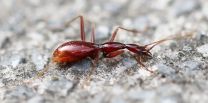(Press-News.org) VIDEO:
What is Nutrigenomix? Here's a primer.
Click here for more information.
Researchers from the University of Toronto (U of T) report that personalized dietary advice based on a person's genetic makeup improves eating habits compared to current "one-size-fits-all" dietary recommendations. The findings were published online today in the journal PLoS One.
"We conducted the first randomized controlled trial to determine the impact of disclosing DNA-based dietary advice on eating habits," says Ahmed El-Sohemy, an Associate Professor in Nutritional Sciences at U of T and Canada Research Chair in Nutrigenomics. "We found that people who receive DNA-based advice improve their diet to a greater extent than those who receive the standard dietary advice. They're also the ones who need to change it the most."
Nutrigenomics is a field of research that aims to understand why some people respond differently than others to the same foods. Personalized nutrition, a branch of personalized medicine, is an application of nutrigenomics that helps tailor dietary recommendations to a person's DNA.
The researchers collected data on the intake of caffeine, sodium, vitamin C and sugar from 138 healthy young adults. The subjects were then randomized into two different study groups--one was given DNA-based dietary advice for each of the four dietary components of interest, and the other group was given current standard dietary advice for the same dietary components with no genetic information.
Changes in their dietary habits were assessed after three and 12 months. The researchers found that subjects who received DNA-based dietary advice started to show improvements to their diets after three months and the changes became even more apparent after 12 months.
Specifically, those who were informed that they carried a version of a gene linked to salt intake and high blood pressure significantly reduced their sodium intake, in accordance with the recommendation, compared to the group that received the standard advice for sodium intake.
No effects were observed for the other components of the diet. However, most subjects were already meeting the dietary recommendations for the three other components at the start of the study, and the researchers believe this might explain why no significant changes were seen in these intakes.
"This study addresses some notable limitations in previous studies that attempted to measure the impact of disclosing genetic information on lifestyle changes," says El-Sohemy. "Previous studies focused on disease risk prediction rather than metabolic genes that affect specific components of the diet. This is the first time that the impact of dietary advice based on diet-related genes with specific actionable advice has been tested."
José M. Ordovás, Director of Nutrition and Genomics at Tufts University, who was not involved in the study, says personalized dietary information not only increases compliance, but also supports the long-term health of patients. "One of the major problems that we have found regarding one-size-fits-all dietary recommendations is people's adherence to them", says Ordovas, a Professor of Nutrition and Genetics. "This work supports the notion that DNA-based recommendations can be more beneficial for the individual and, in addition, will increase his or her compliance, which will increase our ability of preventing chronic diseases using dietary approaches."
The subjects in the study received dietary advice reports that were developed in collaboration with Nutrigenomix Inc., a U of T start-up company that develops genetic test kits for personalized nutrition only through qualified healthcare professionals.
INFORMATION:
Each year, the National Science Foundation (NSF) receives about 50,000 proposals for research funding in all fields of science and engineering from all corners of the country. NSF distinguishes among the proposals through a competitive review process built on two criteria: intellectual merit and broader impacts--will the research advance knowledge and will it benefit society?
Today, NSF released a special report to showcase broader impacts and examples of the diverse and far-reaching ways NSF-supported science touches our lives.
"Intellectual merit and broader impacts ...
Baltimore, Md., November 14, 2014--Most research on spinal cord injuries has focused on effects due to spinal cord damage and scientists have neglected the effects on brain function. University of Maryland School of Medicine (UM SOM) researchers have found for the first time that spinal cord injuries (SCI) can cause widespread and sustained brain inflammation that leads to progressive loss of nerve cells, with associated cognitive problems and depression.
The research, published recently in two articles, one in of the Journal of Neuroscience, the other in Cell Cycle, ...
Boston (Nov. 14, 2014) - After two bombs exploded near the finish line of the Boston Marathon on April 15, 2013, acute trauma to the ears - such as ruptured eardrums - was immediately apparent to those caring for the victims. However, the full extent of the effect on the ears and hearing of victims was not fully recognized for weeks. In the end, more than 100 patients were evaluated for blast-related otologic injuries.
Almost immediately, Boston researchers set out to detail the types of otologic injury and report on the outcomes of patients undergoing otologic treatment. ...
BOZEMAN, Mont. - Hailstones from three Rocky Mountain storms formed around biological material, then bounced around the clouds picking up layers of ice, according to a new Montana State University study.
The discovery of a biological embryo extends previous findings about the formation of snow and rain, applies to hailstones globally and provides basic information about a little-studied topic, said the researchers who published their findings Nov. 6 in the Journal of Geophysical Research: Atmospheres.
"This is the first paper to really show that biological material ...
Researchers at Western University are using cutting-edge genetic mutation-analysis software developed in their lab to interpret mutations in tumour genome that may provide insight into determining which breast cancer tumours are more likely spread to other parts of the body and which ones won't.
Their findings are published today in the journal, Nature Scientific Reports.
"We are using a unique software program in our lab that looks at a type of mutation called a splicing mutation that is typically overlooked using current methods," said lead author on the study, Stephanie ...
Dartmouth researchers have developed a fluorescence imaging technique that can more accurately identify receptors for targeted cancer therapies without a tissue biopsy. They report on their findings in "Quantitative in vivo immunohistochemistry of epidermal growth factor receptor using a receptor concentration imaging approach," which was recently published in Cancer Research.
"Protein overexpression is a hallmark of certain cancers and is used in clinical oncology to personalize treatment through tumor detection, molecular therapies, and therapeutic monitoring," said ...
November 14, 2014 - While noninvasive alternatives are increasingly available, liver biopsy still provides essential information in some children with liver disease, according to a new position paper in the Journal of Pediatric Gastroenterology and Nutrition, official journal of the European Society for Paediatric Gastroenterology, Hepatology and Nutrition (ESPGHAN) and the North American Society for Pediatric Gastroenterology, Hepatology and Nutrition. The journal is published by Lippincott Williams & Wilkins, a part of Wolters Kluwer Health.
The position paper was ...
'We are now living in a world of ubiquitous location: from sat-navs to GPS enabled tablets and smartphones, our everyday activities leave digital and spatially located footprints. This presents tremendous opportunities for explicitly geographical analyses of all kinds of data.'
-Professor Lex Comber, University of Leicester
The work of geographers at the University of Leicester has helped to identify a postcode lottery that increases your risk of developing diabetes or obesity. This and other aspects of how geography can advance our understanding of society will form ...
Devavrat Shah's group at MIT's Laboratory for Information and Decision Systems (LIDS) specializes in analyzing how social networks process information. In 2012, the group demonstrated algorithms that could predict what topics would trend on Twitter up to five hours in advance; this year, they used the same framework to predict fluctuations in the prices of the online currency known as Bitcoin.
Next month, at the Conference on Neural Information Processing Systems, they'll present a paper that applies their model to the recommendation engines that are familiar from websites ...
A team of scientists specializing in cave biodiversity from the South China Agricultural University (Guangzhou) unearthed a treasure trove of rare blind cave beetles. The description of seven new species of underground Trechinae beetles, published in the open access journal ZooKeys, attests for the Du'an karst as the most diverse area for these cave dwellers in China.
"China is becoming more and more fascinating for those who study cave biodiversity, because it holds some of the most morphologically adapted cavernicolous animals in the world. This is specifically true ...



